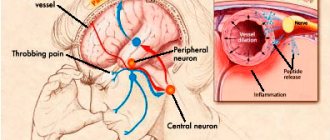The term “sensitization” is used in medicine to describe the process by which various external stimuli have an increased effect on the human body. In addition, this term is used to characterize the process of producing antibodies to infectious agents and other pathogens of various diseases. Based on these processes, desensitization programs are drawn up. Let's look at what sensitization is and consider this concept in various branches of medicine.
Sensitization of an organism in biology is an increase in its sensitivity to the effects of irritants.
What is sensitization
Sensitization in medicine is a process as a result of which the human body actively reproduces antibodies that are used to protect against pathogens of various diseases. The foundation of various desensitization techniques is built on the principles of this process. The desensitization program is based on reducing the influence of provoking factors, which eliminates the body's susceptibility to pathogens. Upon re-entry into the body, the immune system triggers the synthesis of antibodies that destroy harmful microorganisms.
The sensitizing effect is an extraordinary training of the human body, which makes it possible to reduce the influence of aggressive factors. This action is based on the adaptation of internal systems to the negative effects of stimuli in order to prevent their damage.
Sensitization is one of the important components of such a branch of medicine as immunology. As an example, let us consider a situation in which an infectious agent enters the human body. Infection with a virus allows the immune system to trigger the creation of antibodies to destroy harmful microorganisms. The creation of these antibodies allows the immune system to prevent relapse of the disease and counteract the re-entry of bacteria and viruses. Thus, human immunity protects internal systems from dangerous consequences that could cause death.
The term “sensitization” is mentioned quite often in allergology. It is used to describe the development and manifestation of different types of allergic reaction . Household sensitization is the effect of “household” allergens on the human body, which leads to the appearance of allergy symptoms . Based on sensitization, specialists use various methods that help identify the degree of sensitivity to various allergy triggers.
Also, the term “sensitization” is actively used in the field of psychology to explain the phenomenon of increased sensitivity of the nervous system to the effects of various stimuli. According to experts, sensitization of the body has a close relationship with the processes of sensory adaptation. It is important to note that the phenomenon in question is observed in all living organisms . The only difference is the intensity of this process. At its core, sensitization is an increase in the degree of sensitivity, which is the result of exposure to systematic exercises or the actions of various analyzers. Thus, sensitization of the body can be identified through special training.
The process of sensitization makes the body very susceptible to specific substances
According to experts, there are two areas that have an impact on the sensitivity of analyzers. The first group includes various pathologies that disrupt the functioning of sensory analyzers. Such pathologies include blindness. In this example, sensitization of the body is caused by the need to carry out compensatory actions. The second group includes various actions that increase the sensitivity of the analyzers. In this case, importance is given to the specific requirements of various types of activities.
sensitizing effect
- sensitizing effect - rus sensitizing effect (c) eng sensitising effect fra effet (m) sensibilisant deu Sensibilisierungswirkung (f) spa efecto (m) sensibilizante ... Occupational safety and health. Translation into English, French, German, Spanish
- sensitizing effect - 3.16 sensitizing effect: Increasing the body's sensitivity to the effects of irritants that cause an allergic reaction. Source: GOST R 53856 2010: Classification of hazards of chemical products. General requirements... Dictionary-reference book of terms of normative and technical documentation
- Sensitizing effect of chemicals - 25) sensitizing effect, an action caused by the phenomenon of increased sensitivity of the human body to the effects of chemicals and leading to the development of allergic diseases, which has a harmful effect on the environment;...... ... Official terminology
- Occupational poisoning is a pathological condition caused by exposure to toxic substances (industrial poisons) in production conditions. Industrial poisons are a large group of toxic substances and compounds that are used in industry as a starting material... ... Medical encyclopedia
- GOST R 53856-2010: Classification of hazards of chemical products. General requirements - Terminology GOST R 53856 2010: Classification of hazards of chemical products. General requirements original document: 3.1 aspiration: Penetration of a liquid or solid chemical product into the trachea and lower respiratory tract directly through... ... Dictionary of terms of regulatory and technical documentation
- Orthochromatic photography* - (or isochromatic). In the article Photographic Negative (see) it is clarified how the impression of light rays of different colors on the retina of the eye differs from their effect on sensitive silver salts, on the decomposition of which all are based... ... Encyclopedic Dictionary F.A. Brockhaus and I.A. Ephron
- Orthochromatic photography - (or isochromatic). In Art. Negative photo. (see) it was found out how the impression of light rays of different colors on the retina of the eye differs from their effect on sensitive silver salts, on the decomposition of which all the most common ... ... Encyclopedic Dictionary of F.A. Brockhaus and I.A. Ephron
- Aspro vitamin C - Active ingredient ›› Acetylsalicylic acid + Ascorbic acid* (Acetylsalicylic acid + Ascorbic acid*) Latin name Aspro Vitamin C ATC: ›› N02BA51 Acetylsalicylic acid in combination with other drugs (excluding... ... Dictionary of medical drugs
- Colme - Active ingredient ›› Cyanamide Latin name Colme ATX: ›› V03AA Drugs for the treatment of chronic alcoholism Pharmacological group: Drugs for the correction of disorders in alcoholism, toxicity and drug addiction Nosological ... ... Dictionary of medical drugs
- Meningococcus - This article lacks links to sources of information. Information must be verifiable, otherwise it may be questioned and deleted. You can... Wikipedia
- Rabinovich, Adolf Iosifovich - [March 24 (April 5) 1893 September 19. 1942] Sov. physical chemist, member. corr. USSR Academy of Sciences (since 1933). Graduated from Novorossiysk University in 1915 (in Odessa). In 1915 17 he was a laboratory assistant at a factory in Odessa. In 1917 23 he worked at universities in Odessa. Since 1930 prof. Moscow un that,... ...Big biographical encyclopedia
Source: https://occupational_safety_de.deacademic.com/3187/%D1%81%D0%B5%D0%BD%D1%81%D0%B8%D0%B1%D0%B8%D0%BB%D0%B8 %D0%B7%D0%B8%D1%80%D1%83%D1%8E%D1%89%D0%B5%D0%B5_%D0%B4%D0%B5%D0%B9%D1%81%D1 %82%D0%B2%D0%B8%D0%B5
Sensitization of the senses
The influence of the environment has a high power over human sensitivity, which causes internal modifications in the body. The term “sensitivity” denotes the simplest mental processes that reflect the characteristics of surrounding objects, which are the basis of the material world . In addition, this term is used to describe an internal state that is achieved due to the impact of external and internal stimuli on certain receptors.
In a general sense, sensitization of the body is an increase in sensitivity due to the targeted influence of various factors. Thus, the process of interaction of senses is a transformation of certain analyzers under external influence, which leads to changes in many receptors. The following pattern is quite interesting: a strong influence of stimuli that have a coordinated effect reduces the susceptibility of receptors, and a weak influence increases sensitivity.
Sensitizing factors are irritants that increase the sensitivity of the human psyche. Let's take a look at the most common types of factors:
- The combined action of receptors, aimed at strengthening their interaction - the weak expression of sensitivity in one area, increases the strength of the expression of saturation in other areas. For example, slight cooling of the skin increases the skin's sensitivity to light.
- Psychological attitudes - as a result of a long wait for important events, the human psyche becomes maximally susceptible to the action of various irritating factors. For example, we can cite a situation in which waiting to go to the doctor can increase the severity of the pain syndrome.
- The experience gained - certain actions contribute to the development of various sensory analyzers. An example is perfumers who, upon hearing the smell of a perfume, can break its notes into dozens of components.
- The effect of various medications on internal receptors - the use of special pharmaceutical products can have both positive and negative effects on the degree of sensitivity of internal receptors.
Sensitization (from the Latin sensibilis - “sensitive”) is the body’s acquisition of increased sensitivity to foreign substances.
An increase in the degree of excitation of some systems leads to a decrease in the sensitivity of other receptors. The process of irradiation of excitation is associated with the interaction of feelings that are physiological in nature. Most analyzer centers are concentrated in the cerebral cortex.
According to Nobel Prize laureate Ivan Petrovich Pavlov, even minor irritating factors increase the excitation of the nervous system, which extends to the degree of sensitivity of other analyzer systems. Exposure to intense stimuli leads to arousal, which is characterized as a tendency to concentrate. The above process affects the inhibition of many receptors, which leads to a decrease in their sensitivity.
Having studied the pattern of such changes, you can influence the body using specially selected stimuli. The effect of using specific side stimuli is expressed in the form of an increase in the sensitivity of interconnected receptors. This phenomenon has become a kind of basis for many practices used in the fight against drug addiction and alcoholism.
The process of sensitization to drugs and alcoholic beverages is based on the complex use of pharmaceutical products, whose action is aimed at creating a kind of barrier to harmful elements. Using this method allows you to induce a feeling of aversion to the use of mind-altering drugs. The effectiveness of this method of therapy is due to a significant reduction in cravings for the use of substances harmful to the body. After a certain period of time, people with alcohol and drug addiction experience a change in attitude towards their usual lifestyle. At one stage, the patient begins to enjoy his “liberation.” The phenomenon under consideration can be characterized as reflexes of an acquired nature. It should be mentioned that this method is used exclusively in clinical settings, where the patient is under constant medical supervision.
SEARCH
Sensitizing substances, after a relatively short-term effect on the body, cause it to become hypersensitive to this substance.
Subsequent exposure of a sensitized organism to even small amounts of this substance leads to a violent and very quickly developing reaction, often causing skin changes (dermatitis, eczema), asthmatic phenomena, and blood diseases.
Such substances include, for example, mercury, platinum, aldehydes (formaldehyde), aromatic nitro-, nitroso-, amino compounds, etc. [p.40] Obviously, on the same basis it is necessary to establish maximum permissible concentrations for substances with pronounced allergic properties.
However, the sensitivity of people to allergens is so different that the action thresholds, and therefore the MPC for individual people, can differ quite significantly (tens of thousands of times).
Probably, when establishing maximum permissible concentrations for substances that have an allergic effect, one should focus not on the most sensitive people, but on people with common reactions.
Highly sensitive individuals must be freed from contact with the sensitizing substance, which is essentially what is currently being done in industrial settings. [p.34]
During the second maturation, photosensitivity increases. Gelatin plays a significant role in this phenomenon, which, when reacting with silver bromide, forms tiny particles of metallic silver, which are the centers of sensitivity. Adsorption of sensitizing substances found in gelatin also occurs at these centers, which increases spectral sensitivity in certain parts of the spectrum. [p.132]
Hypotheses expressed at different times link differences in the radiosensitivity of animals with the DNA content in their cells, with the vulnerability to ionizing particles of individual chromosomes and the genome as a whole, with the effectiveness of repair systems, with the content of endogenous protective and sensitizing substances and oxygen tension in tissues, with the degree of accumulation toxic substances, the intensity of metabolic processes and [p.157]
However, their photodecomposition can be sensitized by substances with much lower excitation energies in this photoly [p.128]
Ethylbenzene can be used as a second component during oxidation, which, as a result of the described reaction scheme, is converted into styrene [47]. High selectivity for the formation of isoamyl hydroperoxide can be achieved by photo-oxidation of isopentane in the presence of sensitizing substances [48]. [p.274]
Electronically excited benzophenone can oxidize isopropanol to acetone. When benzophenone is irradiated with ultraviolet light with >. = 284 nm in a solution of 20% isopropaiol and 80% benzene, the quantum yield of energy transfer is 0.9 0.1. Further, Schulte-Frolinde et al.
[207, 208] showed that radiolysis of the same system causes the formation of acetone with O = 2.
They suggested that in both cases benzophenone is the sensitizing substance (however, the excitation of benzophenone can be caused by energy transfer from various excited states of benzene, and C = 2 is only a measure of the total amount of energy transferred). [p.131]
The two types of occurrence of sensitizing atoms and molecules just discussed represent a tempting working hypothesis for further research into chemical sensitization. Indeed, both types can be implemented practically.
However, it has recently become clear that such theoretical speculations on the detailed nature of chemical sensitization, although they stimulated further research, did not lead to lasting advances in this field.
This is due to the lack of experimental data on the properties of the surfaces of silver halide crystals coated with layers of sensitizing substances. For example, it is unknown whether the presence of such surface layers will cause spontaneous fogging of the crystal.
It is also unknown what the main role of these layers is - in capturing electrons or positive holes. Thus, the need for a new, more in-depth study of chemical sensitization became quite obvious. [p.14]
Hedges and Mitchell showed that the primary function of a chemical sensitizer is to facilitate the formation of a surface latent image by combining the sensitizer with bromine, which would otherwise destroy the latent image. This view is consistent with the conclusions made long ago by Hickman [2].
However, Hedges and Mitchell were aware that the system they studied was much less complex than a photographic emulsion, and that the results obtained with it could only explain some aspects of the problem of chemical sensitization. Based on these results alone, a correct model for the sensitized microcrystal could not be proposed.
[p.52]
Ruthenium hydroxychloride is a sensitizing substance that, after relatively short exposure [p.19]
If we consider relatively low-disperse (negative) emulsions, the crystallization process of which is traced using an optical microscope, then it can be shown that this process practically stops during the second ripening (see sections P.3 and III.1).
It follows that chemical sensitization occurs in this case on the surface of emulsion microcrystals and consists of certain topochemical transformations.
Obviously, the latter should begin with the adsorption of sensitizing substances on the inhomogeneous surface of real crystals, disturbances of which are created by intrinsic lattice defects (exits of dislocations and other substructural elements).
Therefore, we can assume that the initial moment of sensitization lies in the formation of adsorption complexes, some of which, when passing into solution, can cause etching, i.e., increased surface damage to microcrystals.
The possibility of such a phenomenon is indeed confirmed by direct experiments [25], as can be seen from Fig. VIII.6. Shown here is the dependence of the time of appearance of the first etching marks on the thiosulfate concentration. Observations were made under oblique illumination in order to more confidently detect the moment of the beginning of etching. [p.320]
Adsorption complexes formed on the surface can, under certain conditions, decompose and create impurity centers. Moreover, the available experimental data indicate a high probability of the existence of silver low-atomic centers.
However, a significant proportion of sensitizing substances remains in the adsorbed state. Consequently, chemical sensitization causes surface changes in emulsion microcrystals, namely the strengthening of lattice defects, the formation of adsorption complexes and, finally, silver impurity centers.
All these changes have a beneficial effect on photographic sensitivity. [p.337]
Damage to cells by densely ionizing radiation is poorly modified by oxygen; the damaging effect of this radiation remains almost unchanged under hypoxic conditions (Fig. 15). The same applies to the use of radioprotective or sensitizing substances (Fig. 16 and 17) (Belbaz et al., 1962 [p.25]
According to the authors of the hypothesis, not only artificially modified, but also natural radioresistance is determined by the ratio of the levels of endogenous protective and sensitizing substances.
This ratio was designated as a regulatory complex that determines the development of primary radiation processes and, as a consequence, the resistance of biological objects to the effects of radiation. Thus, the problem of radioresistance is considered by the hypothesis from the standpoint of the biophysical mechanisms of primary radiation reactions, i.e.
The background against which the initial physico-chemical processes of radiation injury unfold is examined. It is assumed that the lipids of biomembranes are specific targets for ionizing radiation, and the composition [p.289]
See pages where the term Sensitizing substances : [p.311] [p.71] [p.70] [p.131] [p.128] [p.442] [p.210] [p.22] [c .41] [p.488] [p.104] [p.
145] [p.190] [p.290] Occupational safety and fire protection in the chemical industry (1982) - [p.71]
Labor protection in the oil refining and petrochemical industry (1983) - [ p.
40 ]
© 2021 chem21.info Advertising on the site
Source: https://chem21.info/info/400412/
Sensitization in children
Many parents are concerned about the question of what child sensitization is. In this case, sensitization means an increase in the body’s activity to repeated exposure to various stimuli. The result of this activity is increased sensitivity. This explains the fact that a single exposure to external stimuli may not provoke arousal, but repeated exposure to stimuli will force the child to perform a certain set of actions.
The influence of stimuli on the body is closely related to the age stage of development.
According to experts, the highest degree of severity of the phenomenon in question is observed in preschool age. In infancy, the work of the analytical centers is based on reflection, but as they grow older, their functionality increases. Sensory systems gradually increase in sensitivity, which reaches its peak between the ages of twenty and thirty. Further, the susceptibility of the receptors gradually declines.
Human feelings are formed over many years and change throughout life. On their basis, a sensory organization is formed. It is important to note that personality formation may be based on limited sensory perception. The loss of several analyzer systems can be compensated by an increase in the activity of other centers. As an example, we can say that people who are deaf have the ability to listen to music by touching a musical instrument that emits vibrations that are inaccessible to healthy people.
In the field of allergology, sensitization is an inflammatory response of the immune system to the action of allergens.
Synesthesia and sensitization
Sensitization of the body can be caused by many external irritants that are present in the environment. Irritation of one analyzing system can cause different sensations that are characteristic both for it and for other receptors. This phenomenon is called “synesthesia”. This phenomenon can have many forms of expression. Often, most people experience synesthesia in the area of visual-auditory receptors. This phenomenon manifests itself in the form of visual images when exposed to certain sound stimuli. It is important to note that such images have increased stability for various personality types.
The phenomenon of the relationship between synesthesia and sensitization is used as evidence of the existence of a close connection between analytical systems and the unity of sensitive sensors . This phenomenon is the basis of the technology for creating color music equipment that transforms sounds into color images. The formation of taste sensations in the form of a reaction to the influence of auditory sensors is much less common.
It is important to note that synesthesia is observed only in a small number of individuals. Examples of this phenomenon include gustatory synesthesia, which is characterized as taste sensations evoked by certain phrases. So the mention of lemon can provoke a feeling of citric acid in the mouth.
Sensitization - types, causes, adaptation
Sensitization is an increase in the sensitivity of nerve centers under the influence of an irritant. Increased sensitivity can occur during anticipation of a significant signal, through experience, or as a result of exercise.
It may be due to specific activity requirements or arise as a result of compensation for sensory defects. An example of sensitization in the first case is the high sensitivity of the artist's eye to the proportionality of shapes and the consistency of colors and shades.
In the second, it is an increase in hearing and remote sensitivity to obstacles in blind people.
Sensitization, adaptation and synesthesia are directly related to changes in the sensitivity of analyzers and relate to the qualitative characteristics of sensations.
Sensitization of sensations
Sensitization of sensations is an increase in sensitivity that occurs under the influence of the following internal factors:
- System operation of analyzers and their interaction. When the intensity of sensations in one modality is low, sensations in another modality intensify. For example, when the skin cools slightly, light sensitization appears;
- Pharmacological effects on the body. The introduction of various substances, such as adrenaline or phenamine, causes a significant increase in receptor sensitivity;
- Psychological attitude. Anticipation of any event, especially a significant one, can tune in to a clearer perception of stimuli. Thus, an upcoming visit to the dentist may provoke increased toothache;
- Gained experience. In the process of performing a particular activity, certain sensory systems gradually develop. Examples of sensitization include experienced tasters who conduct sensory analysis based on subtle nuances, or musicians who distinguish by ear the relative duration of notes.
As a result of strong excitation of some analyzers, the sensitivity of others may decrease. Desensitization is typical, for example, for workers in industrial workshops, since high noise levels somewhat impair vision.
Compensatory sensitization occurs when various types of sensations are suppressed or absent, when this deficiency is compensated for by increasing the susceptibility of other analyzers. For example, hearing improves in the dark.
Sensitization and adaptation
If sensitization is associated exclusively with an increase in sensitivity depending on psychological or physiological factors, then adaptation is determined by the environment and is characterized by both an increase and a decrease in sensations. Adaptive abilities manifest themselves, for example, when there is a sudden change in lighting level - it takes some time for the eyes to adapt to darkness or bright light.
Based on the severity of sensations, there are 2 types of adaptation:
- Anesthesia. Occurs with prolonged exposure to an irritant, which leads to the complete disappearance of sensations. For example, during the day people do not feel the touch of clothing or do not pay attention to the wedding ring;
- Dulling of the intensity of feelings. Expressed as a reaction to strong stimuli. This may be getting used to a strong smell in medical institutions or in a perfume store.
The synthesis of adaptation and sensitization is carried out during the structuring of disordered elements. Paintings up close may look like chaotic spots of color, in which the painting becomes visible over time.
In constant background noise, individual sounds can also gradually be distinguished.
That is, in the process of getting used to an intense external stimulus, it becomes possible to analyze it, and focusing attention on individual elements helps to increase susceptibility to them.
Sensitization and synesthesia
Sensitization and synesthesia are closely related properties of sensations. With synesthetic perception, stimulation of one sense organ is accompanied by sensations corresponding to another organ. The most common example of sensitization with a change in modality is the occurrence of a sour taste at the sight of lemon.
It is also common for visual images to appear while listening to music or reading. From a neurological point of view, this phenomenon is explained by the fact that the excitation of nervous structures radiates from one modality to another, resulting in the formation of many synesthetic sensations - “color” hearing, “taste” of words, “smell” of color and other options.
Synesthesia is also considered to be the basis of metaphorical evaluations and transferences.
Sensitization of sensations can manifest itself when comparing various stimuli. For example, a light figure against a black background will appear white.
A gray area on a green background will appear reddish, and on a red background, on the contrary, it will take on a green tint. Vertical lines appear longer than horizontal lines, although they are objectively the same length.
The contrast of sensations is often played out in advertising, painting, clothing and interior design.
Research shows that sensitization also depends on the following factors:
- Age. The increase in receptor susceptibility continues until the age of 30 and then slowly decreases;
- Type of nervous system. People with a weak nervous system who do not have endurance and stability are more predisposed to sensitization.
- Endocrine balance of the body. During pregnancy, sensitization of the olfactory sensations is observed.
Temporary sensitization is caused by an inhibitory state of the cerebral cortex that occurs during overwork.
Perception is involved in shaping behavior. Changing the sensitivity of analyzers and the interrelation of sensations ensure the receipt and processing of information about the surrounding world.
Found an error in the text? Select it and press Ctrl + Enter.
Source: https://www.neboleem.net/psihologija-otnoshenij/7643-sensibilizacija.php
Sensitization in psychology
The concept of sensitization is used in psychology to describe the process of increasing the sensitivity of nerve receptors with the help of external stimuli. Sensitization is used by musicians to develop auditory perception, and by tasters to develop taste and olfactory sensors. From a psychological point of view, such an impact can be both short-term and long-term.
Long-term sensitization is the result of unconscious actions or training aimed at achieving specific goals. The short-term phenomenon of excitation of nerve receptors is associated with taking medications or exposure to certain conditions, which contribute to aggravation of the senses. This method is used as a tool that creates a feeling of fear in the patient, which helps prevent the development of unfavorable situations.









